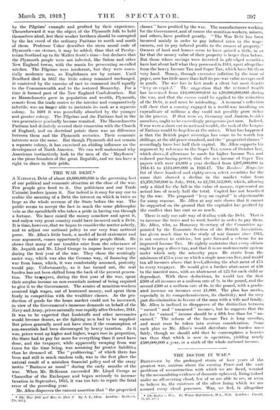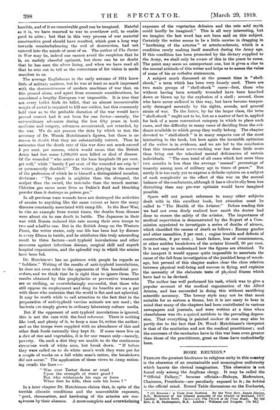THE DOCTOR IN WAR.• DErnr.mtm by the prolonged strain of
four years of the greatest war, anxious about the ensuing Peace and the vast problems of reconstruction with which we are faced, worried by the accumulating evidence of domestic upheaval, living indeed antler an all-covering cloud, few of us are able to see, or even to believe in, the existence of the silver lining which we aro assured every cloud possesses. War, we feel, is altogether
• The 11oAcr r true. By Woos, Ilutchinscn, M.A., 3LD, London Conseil. to. Gt. net.)
horrible, and of it no conceivable good can be imagined. Hateful as it is, we have resorted to war to overthrow evil, to enable good to arise ; but that in this very process of war material constructive good should have resulted, which goes a long way towards counterbalancing the evil of destruction, had not entered into the minds of most of us. The author of The Doctor in War may be, indeed one cannot avoid the suspicion that he Is, an unduly cheerful optimist, but there can be no doubt that he has seen the silver lining, and when we have read all that he sets out to tell us the correctness of his vision is made manifest to us.
The average Englishman in the early autumn of 1914 knew little of military matters, but he was at least so much impressed with the destructiveness of modern machines of war that, on this ground alone, and apart from economic considerations, he considered a lengthy European war impossible. It is true that not every bullet finds its billet, that an almost inconceivable weight of metal is required to kill one soldier, but this commonly held view as to the probable duration of the war would have proved correct had it not been for one factor—namely, the extraordinary advances during the last fifty years in both medicine and surgery, advances accentuated, not retarded, by the war. We do not possess the data by which to test the accuracy of Dr. Woods Hutehinson's figures, but there is no reason to doubt that they are substantially correct. Thus he estimates that the death rate of this war does not much exceed 5 per cent. per annum, which would mean that the British Army had lost some 1,200,000 men killed or died of disease. Of the wounded " who arrive at the base hospitals 98 per cent. get well," while " barely 2 per cent. of the wounded are crip- le 1 or permanently disabled." The writer, glorying in the success of the profession of which he is himself a distinguished member, declaims "The spade ie mightier than the shrapnel, the scalpel than the sword, the test-tube than the trench mortar. Chlorine gas saves more lives as Dakin's fluid and bleaching powder than it destroys as poison gas."
In all previous wars wounds have not destroyed the activities of armies to anything like the same extent as have the many diseases constantly associated with camp life. In the Boer War, to cite an example from recent times, the deaths from disease were about six to one death in battle. The Japanese in their war with Russia reduced this rate among their own troops to two and a half to one. But in the British Army on the Western Front, the writer states, only one life has been lost by disease to every fifteen in battle, and he attributes this truly astounding result to three factors—anti typhoid inoculations and other Measures against infectious disease, surgical skill and superb hospital organization, and the splendid way in which the armies have been fed.
Dr. Hutchinson has no patience with people he regards as " faddists." Writing of the results of anti-typhoid inoculations, he does not even refer to the opponents of this beneficial pro- cedure, and we think that he is right thus to ignore them. Tho • results obtained by this prophylactic or preventive treatment are so striking, so overwhelmingly successful, that those who still oppose its employment and deny its benefits are on a par with those who maintain that the world is fiat and not spherical. It may be worth while to call attention to the fact that in the preparation of anti-typhoid vaccine animals are not used ; the bacteria are simply grown in ordinary laboratory culture media.
But if the opponent of anti-typhoid inoculations is ignored, this is not the case with the food reformer. There is nothing like beef, and plenty of it, to keep a man fit, writes the author; and as the troops were supplied with an abundance of this and other flesh foods naturally they kept fit. If some races live on a diet of rice and vegetables, it is for one reason only—namely, poverty. On such a diet they are unable to do the continuous strenuous work of white men, but break down. "If before they were called on to do white men's work they were put for a couple of weeks on a full white man's ration, the breakdown did not occur." The application of these views to Army ration- ing recalls the lines:— "Was ever Tartar fierce or cruel
Upon the strength of water gruel
But who withstands his rage or force When first he kills, then eats his horse ? "
In a later chapter Dr. Hutchinson claims that, in spite of the terrible climatic conditions and the unavoidable exposure, " gout, rheumatism, and hardening of the arteries are con- spicuous by their absence. A more complete and overwhelming
exposure of the vegetarian delusion and the uric acid myth could hardly be imagined." This is all very interesting, but we imagine the last word has not been said on this subjeot. Certainly the writer seems to be a little unwise in dragging in " hardening of the arteries " or arterioaelerosie, which is a condition rarely making itself manifest during the Army age. If this condition has been promoted by the dietary supplied to the Army, we shall only be aware of this in the years to come. The point may seem an unimportant one, but it gives a clue to the mental attitude of this writer and helps us to assess the value of some of his ex cathedra statements.
A subject much discussed at the present time I. " shell- ehock," a term which has been very loosely used. There are two main groups of " ehellahock " eases—first, dorm who without having been actually wounded have been knocked down or blown up by the explosion of a shell ; second, those who have never suffered in this way, but have become tempor- arily deranged mentally by the eights, sounds, and general strain of war. To the latter, by far the larger class, the term " shell-shock " ought not to be, but as a matter of fact is, applied for lack of a more convenient category in which to place such cases, and the difficulty in many cases of deciding from the evi- dence available to which group they really belong. The chapter devoted to " shell-shock " is in many respects one of the most interesting in the book, but here again the incurable optimism of the writer is in evidence, and we are led to the conclusion that this tremendous nerve-racking war has done little more than bring out the inherited mental deficiencies of certain individuals. "The sum total of all cases which last more than two months is lest: than the average ' normal ' percentage of insanity among men of military age in times of peace." But surely it is too early yet to express a definite opinion on a subject of such complexity as the effect of this war on the mental balance of the combatants, although it has undoubtedly been less disturbing than any pre-war optimist would have imagined possible.
Space will not permit reference to many other subjects dealt with in this excellent book, but attention must be called to- " The Health of the Aviator." Before reading this we had not even dimly realized how much the doctor had done to ensure the safety of the aviator. The importance of medical supervision is demonstrated by the Report of a Com- mission appointed to investigate a series of deaths of airmen, which classified the causes of death as follows : Enemy gunfire and other casualties, 2 per cent. ; engine trouble and defects of construction, 8 per cent. ; heart failure, lose of consciousness, or other sudden breakdown of the aviator himself, 90 per cent. It is not easy to understand how the figures are obtained. To the inexpert it would appear quite impossible to ascertain the cause of the fall from investigation of the jumbled heap of wreck- age, but perusal of this chapter makes clear the close relation between physical well-being and success in flying, and explains the necessity of the elaborate tests of physical fitness which have had to be devised.
The author has well performed his task, which was to give a popular account of the medical organization of the Allied Armies, and has succeeded in doing this without sacrificing scientific accuracy. The breezy style may not be that most suitable for so serious a theme, but it is nec scary to bear in mind that many of the chapters had been contributed to various newspapers and journals, and were written at a time when cheerfulness was the required antidote to the prevailing depres- sion. That everything is painted couleur de rose may also be partly due to the fact that Dr. Wood: Hutchinson's viewpoint is that of the sanitarian and not the medical practitioner ; and the successes of the sanitarian have in this war been even greater than those of the practitioner, great as therm: have undoubtedly been.



































 Previous page
Previous page